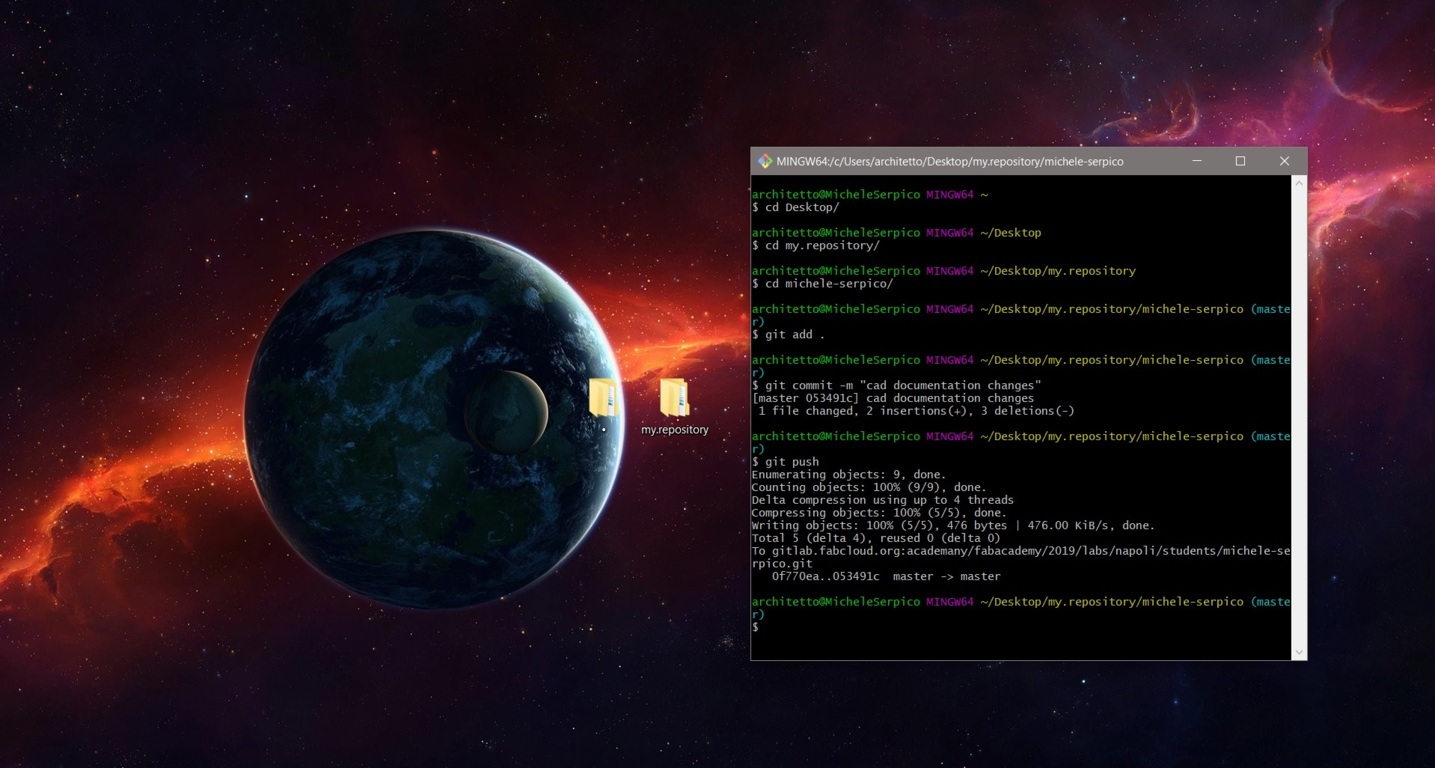2. Project management¶
This week I started to getting used to the documentation process. So I learnt managing and sharing contents using git bash and editor softwares with many languages.
Git bash¶
1st I joined GitHub the web-based hosting service where people can create and share repositories.
2nd I downloaded Git Bash and creating an SSh key I also joined to Git Lab Fab community, to pull and push data.
// To show the data list of your source ls // To choose directions of data you want manage cd // To generate a safety key to let you access to data ssh-keygen // To update the connection from the remote to the local git pull // To upload data from local to remote git add . // To add message to data you're adding git commit -m "message" // To complete the uploading git push
And following this guide I learnt other deep functions of Git Bash.

3rd So I started making my Fab Academy student page, downloading and installing mkdocs:
$ pip install mkdocs && mkdocs --version
4th And all the mkdocs material.
$ git clone https://github.com/squidfunk/mkdocs-material.git Cloning into 'mkdocs-material'... remote: Enumerating objects: 77, done. remote: Counting objects: 100% (77/77), done. remote: Compressing objects: 100% (48/48), done. remote: Total 14805 (delta 35), reused 41 (delta 14), pack-reused 14728 Receiving objects: 100% (14805/14805), 14.75 MiB | 1.17 MiB/s, done. Resolving deltas: 100% (9373/9373), done.
5th So following the respective guide I customazed my .yml home page.
site_name: Michele Serpico
site_description: Michele Serpico Fab Academy student 2019
site_author: Michele Serpico
docs_dir: docs
site_dir: _site
copyright: Creative Commons Attribution Non Commercial
theme:
logo: "docs/images/logo.svg"
favicon: "docs/images/favicon.ico"
name: material
palette:
primary: "white"
accent: "indigo"
font:
false
feature:
tabs: true
extra:
social:
- type: "github"
link: "https://github.com/micheleserpico"
- type: "facebook"
link: "https://www.facebook.com/michele.serpico"
markdown_extensions:
- extra
- smarty
- admonition
- codehilite:
guess_lang: false
- toc:
permalink: true
Languages¶
And downloading editors as Atom and Brackets I approached to language codes.
Markdown¶
A lightweight markup language with plain text formatting syntax. Its design allows it to be converted to many output formats, but the original tool by the same name only supports HTML.
// .md is the the markdown format file name: week02.md // write one or more # to use titles and subtitles # 2. Project management This week I started to getting used to the documentation process. So I focused to the basis of websites scripting and took part to the Fab Academy web community, learning to use: ## Markdown // use ** at the begin and at the end of paragraphs or words to writh them in bold **Markdown**. - A lightweight markup language with plain text formatting syntax. Its design allows it to be converted to many output formats, but the original tool by the same name only supports HTML. // use ** at the begin and at the end of paragraphs or words to writh them in bold. **Guide** // to highlight a link write it between square brackets, and then in round brackets write the link's path to dividing folders. [Markdown](https://about.gitlab.com/handbook/product/technical-writing/markdown-guide/) guide link
HTML¶
Hypertext Markup Language is standard markup language, a system for annotating a document in a way that is syntactically distinguishable from the text, and so for creating web pages and web applications. To write in this languages the content has to be written in a symmetrical code.
<!DOCTYPE html> <html> <body> <h1>My HTML example<h1> <p> Hypertext Markup Language is a standard markup language, a system for annotating a document in a way that is syntactically distinguishable from the text, and so for creating web pages and web applications. <p> <tagname>content goes here...</tagname> <img src="../images/sample-pic-2.jpg" alt="sample" width="40" height="70"> <a href="http://fabacademy.org/2019/labs/napoli/students/michele-serpico/assignments/week02/"> <body> <html>
CSS¶
(Cascading Style Sheets) - A style sheet language used for describing the presentation of a document written in a markup language like HTML. CSS is designed to enable the separation of presentation and content, including layout, colors, and fonts. This separation can improve content accesibility, provide more flexibility and control in the specification of presentation characteristics, enable multiple web pages to share formatting by specifying the relevant CSS in a separate .css file, and reduce complexity and repetition in the structural content. -
file name: week02.css
body {
background-color: red;
}
h1 {
color: white;
text-align: center;
}
p {
font-family: arial;
font-size: 20px;
}